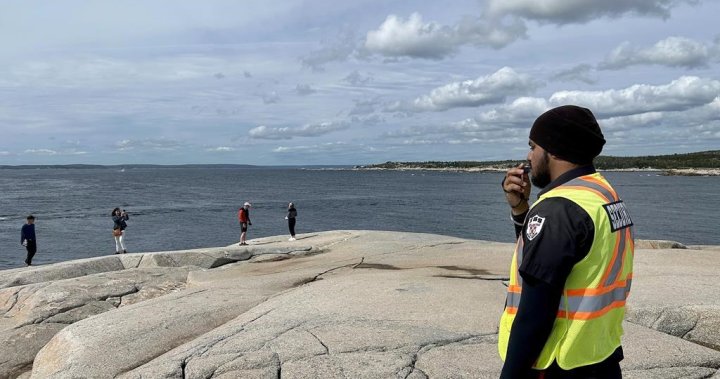Breaking News
Peggy’s Cove danger: How guardians keep visitors safe at beautiful but deadly tourist site

Japneet Singh, a security patroller at Nova Scotia’s famed Peggy’s Cove — a longtime treasure of Atlantic Canada’s coastline southwest of Halifax — is no stranger to the perils of the sea.
Singh’s summer job is to watch over the black rocks overlooking the Atlantic Ocean, which are routinely slapped violently with salty waves, and covered in slippery algae that can take an unsuspecting visitor by surprise. But despite its dangers, Peggy’s Cove, with its red-and-white lighthouse and sprawling granite terrain, attracts roughly 700,000 visitors each year and is one of Canada’s most photographed sites.
Keeping a watchful eye for visitors who wander too close to the water’s edge, Singh blows his whistle to urge them back onto shore. He is part of a patrol program launched by the province in August 2022, four months after a 23-year-old man was killed after getting swept into the ocean by a wave. Patrollers are on site 12 hours a day, seven days week, from May to January.
“People think even if they slip in (the water), it’s going to be easy to swim through it. But there have been casualties every year beforehand,” Singh said in an interview Friday, a day he and his co-patroller had to intervene 39 times with people getting dangerously close to the water. Normally, he said, there are between 60 and 80 interventions a day.
“Most people think it’s pretty calm, but after you go like 15 or 20 metres away from the shore, the water level drops from 50 to 100 metres and it’s pretty hard to swim in that condition,” he said.
He’s seen some close calls this summer. On multiple occasions a rogue wave washed up just seconds after he had warned visitors to get off the black rocks. Tourists, he said, get so caught up in the scenery they don’t realize where they’re standing.

Get breaking National news
For news impacting Canada and around the world, sign up for breaking news alerts delivered directly to you when they happen.
Singh said that even on calm days, visitors can slip on the rocks’ algae, or even worse, be hit with a rogue wave — unpredictable surface waves that form suddenly without warning — and be swept out into dangerous currents.

The only person to fall in the water this season was a teenage boy who ignored a patroller’s warnings to get off the rocks, but was luckily able to get out of the water with the help of his friends, Singh said.
Since the program reopened for the season in May, patrollers have had more than 4,100 interactions with visitors, according to Brennan McGinnis, a manager with the private security company that dispatches the patrollers, Independent Security Services Atlantic Inc. McGinnis said the fact that nobody has died this summer at Peggy’s Cove is a “very big win.”
In 1995, the province’s Tourism Department began hiring students to patrol the rocks in the summer to keep people from getting too close to the ocean. The program was suspended in the spring of 2000 — a controversial move at the time — when the government decided it was too dangerous for students to be working on the rocks.
Since then, there have been multiple calls from the public to have better safety programs in place, including proposals to build fences around the historic site. The province built a viewing platform at the site in 2021 to keep gawkers safe. Warning signs are also present, one of which reads, “Injury and death have rewarded careless sightseers here. The ocean and rocks are treacherous. Savour the sea from a distance.”
According to Toronto Metropolitan University tourism professor Wayne Smith, keeping people safe at dangerous tourist sites is a balancing act. “There’s a whole marketing (thing) … You want people to come to your community and have a great time. You want them to take wonderful pictures, but you don’t want them to get injured,” Smith said in an interview.
Smith said for many folks — at Peggy’s Cove or elsewhere — being on vacation invites reckless behaviour as they try to get the perfect souvenir photo.
Despite calls from locals to post lifeguards at Peggy’s Cove, the strength of the waves, ocean’s current and rocky conditions make for too hazardous a recipe for even the strongest swimmers, said Paul D’Eon, president of the Nova Scotia Lifesaving Society.
“I have surf guards around the province and I’ve had them go and evaluate the site and they just shake their heads,” D’Eon said.
D’Eon said people who fall in the water are sucked into the backwash of the ocean. Attempts to climb back out can be futile, and it’s not possible to send rescue boats in without getting battered by the rocky shore.
Though there isn’t data available on the number of drownings across Nova Scotia’s most popular landmarks, D’Eon says Peggy’s Cove is the most fatal place in the province. He said the patrol program is needed because each interaction between a patroller and visitor can easily turn into a much deadlier statistic.
“They’re doing numerous interventions every day and every one of those is a potential tragedy,” he said.
© 2024 The Canadian Press
-

 Destination8 months ago
Destination8 months agoSingapore Airlines CEO set to join board of Air India, BA News, BA
-

 Breaking News10 months ago
Breaking News10 months agoCroatia to reintroduce compulsory military draft as regional tensions soar
-

 Gadgets3 months ago
Gadgets3 months agoSupernatural Season 16 Revival News, Cast, Plot and Release Date
-

 Tech News12 months ago
Tech News12 months agoBangladeshi police agents accused of selling citizens’ personal information on Telegram
-

 Productivity11 months ago
Productivity11 months agoHow Your Contact Center Can Become A Customer Engagement Center
-

 Gadgets3 weeks ago
Gadgets3 weeks agoFallout Season 2 Potential Release Date, Cast, Plot and News
-

 Breaking News10 months ago
Breaking News10 months agoBangladesh crisis: Refaat Ahmed sworn in as Bangladesh’s new chief justice
-

 Toys12 months ago
Toys12 months ago15 of the Best Trike & Tricycles Mums Recommend
























